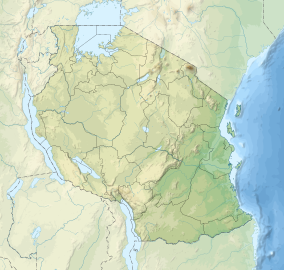
Maasai Mara, also sometimes spelled Masai Mara and locally known simply as The Mara, is a large national game reserve in Narok, Kenya, contiguous with the Serengeti National Park in Tanzania. It is named in honor of the Maasai people, the ancestral inhabitants of the area, who migrated to the area from the Nile Basin. Their description of the area when looked at from afar: "Mara" means "spotted" in the local Maasai language, due to the many short bushy trees which dot the landscape.
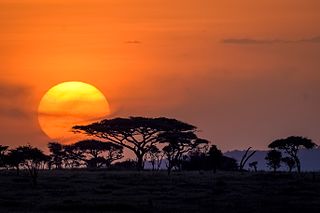
The Serengeti ecosystem is a geographical region in Africa, spanning the Mara and Arusha Regions of Tanzania. The protected area within the region includes approximately 30,000 km2 (12,000 sq mi) of land, including the Serengeti National Park and several game reserves. The Serengeti hosts the second largest terrestrial mammal migration in the world, which helps secure it as one of the Seven Natural Wonders of Africa, and as one of the ten natural travel wonders of the world.

Wildebeest, also called gnu, are antelopes of the genus Connochaetes and native to Eastern and Southern Africa. They belong to the family Bovidae, which includes true antelopes, cattle, goats, sheep, and other even-toed horned ungulates. There are two species of wildebeest: the black wildebeest or white-tailed gnu, and the blue wildebeest or brindled gnu.

The Serengeti National Park is a large national park in northern Tanzania that stretches over 14,763 km2 (5,700 sq mi). It is located in eastern Mara Region and northeastern Simiyu Region and contains over 1,500,000 hectares of virgin savanna. The park was established in 1940.
Tsavo East National Park is a national park in Kenya with an area of 13,747 km2 (5,308 sq mi). It was established in April 1948 and covers a semi-arid area previously known as the Taru Desert. Together with the Tsavo West National Park, it forms an area of about 22,000 square kilometers. The Tsavo River flows west to east through the national park, which is located in the Taita-Taveta County of the former Coast Province.
Amboseli National Park, formerly Maasai Amboseli Game Reserve, is a national park in Kajiado South Constituency in Kajiado County, Kenya. It is 39,206 ha (392.06 km2) in size at the core of an 8,000 km2 (3,100 sq mi) ecosystem that spreads across the Kenya-Tanzania border. The local people are mainly Maasai, but people from other parts of the country have settled there attracted by the successful tourist-driven economy and intensive agriculture along the system of swamps that makes this low-rainfall area, average 350 mm (14 in), one of the best wildlife-viewing experiences in the world with 400 species of birds including water birds like pelicans, kingfishers, crakes, hamerkop and 47 raptor species.

The Masai giraffe, also spelled Maasai giraffe, and sometimes called the Kilimanjaro giraffe, is a species or subspecies of giraffe. It is native to East Africa. The Masai giraffe can be found in central and southern Kenya and in Tanzania. It has distinctive jagged, irregular leaf-like blotches that extend from the hooves to its head. The Masai giraffe is currently the national animal of Tanzania.
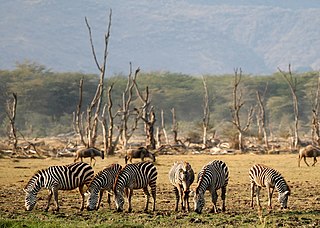
Lake Manyara National Park is a protected area in Tanzania's Arusha and Manyara Regions, situated between Lake Manyara and the Great Rift Valley. It is administered by the Tanzania National Parks Authority, and covers an area of 325 km2 (125 sq mi) including about 230 km2 (89 sq mi) lake surface. More than 350 bird species have been observed on the lake.

Saadani National Park is Tanzania's 13th national park and has an area of 1,062 km2 (410 sq mi). It was officially gazetted in 2005 and is managed under the Tanzania National Parks Authority. The park is located administratively in southeast Pangani District of Tanga Region and northeast Chalinze District of Pwani Region.

Grant's zebra is the smallest of the seven subspecies of the plains zebra. This subspecies represents the zebra form of the Serengeti-Mara ecosystem and others across central Africa.
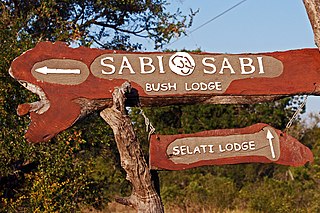
Sabi Sabi is a private game reserve in South Africa, situated in the Sabi Sand Game Reserve which flanks the south western section of the Kruger National Park. The Sabi Sand Reserve is one of the parks that make up the Greater Kruger National Park.

The wildlife of Botswana refers to the flora and fauna of this country. Botswana is around 90% covered in savanna, varying from shrub savanna in the southwest in the dry areas to tree savanna consisting of trees and grass in the wetter areas. Even under the hot conditions of the Kalahari Desert, many species survive; in fact the country has more than 2500 species of plants and 650 species of trees. Vegetation and its wild fruits are also extremely important to rural populations living in the desert and are the principal source of food, fuel and medicine for many inhabitants.

The wildlife of Zimbabwe occurs foremost in remote or rugged terrain, in national parks and private wildlife ranches, in miombo woodlands and thorny acacia or kopje. The prominent wild fauna includes African buffalo, African bush elephant, black rhinoceros, southern giraffe, African leopard, lion, plains zebra, and several antelope species.

The Eastern miombo woodlands (AT0706) are an ecoregion of grassland and woodland in northern Mozambique, southern Tanzania, and southeastern Malawi.
Mikumi National Park is a national park near Morogoro, Tanzania with an area of 3,230 km2 (1,250 sq mi) that was established in 1964. It is the fourth largest in the country. The park is crossed by Tanzania's A-7 highway.

Tanzania contains some 20 percent of the species of Africa's large mammal population, found across its reserves, conservation areas, marine parks, and 17 national parks, spread over an area of more than 42,000 square kilometres (16,000 sq mi) and forming approximately 38 percent of the country's territory. Wildlife resources of Tanzania are described as "without parallel in Africa" and "the prime game viewing country". Serengeti National Park, the country's second largest national park area at 14,763 square kilometres (5,700 sq mi), is located in northern Tanzania and is famous for its extensive migratory herds of wildebeests and zebra while also having the reputation as one of the great natural wonders of the world. The Ngorongoro Conservation Area, established in 1959, is a UNESCO World Heritage Site and inhabited by the Maasai people. Its Ngorongoro Crater is the largest intact caldera in the world.

The Tarangire River is a perennial river located in central Manyara Region in the eastern branch of the East African Rift Valley, within northern Tanzania.
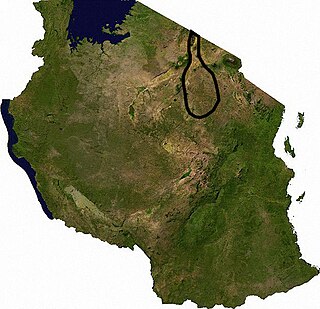
The TarangireEcosystem is a geographical region in Africa. It is located in northern Tanzania and extends between 2.5 and 5.5 degrees south latitudes and between 35.5 and 37 degrees east longitudes.

The spotted hyena is the most carnivorous member of the Hyaenidae. Unlike its brown and striped cousins, the spotted hyena is primarily a predator rather than a scavenger. One of the earliest studies to demonstrate its hunting abilities was done by Hans Kruuk, a Dutch wildlife ecologist who showed through a 7-year study of hyena populations in Ngorongoro and Serengeti National Park during the 1960s that spotted hyenas hunt as much as lions, and with later studies this has been shown to be the average in all areas of Africa. However spotted hyenas remain mislabeled as scavengers, often even by ecologists and wildlife documentary channels.

The Southern Acacia–Commiphora bushlands and thickets is a tropical grasslands, savannas, and shrublands ecoregion in Tanzania and Kenya. It includes portions of Serengeti National Park and Ngorongoro Conservation Area, which are designated World Heritage Sites and biosphere reserves for their outstanding wildlife and landscapes. It is one of three Acacia–Commiphora bushlands and thickets ecoregions in eastern Africa.


